Diffusion MRI: Applications
Oral
Diffusion
Thursday, 21 June 2018
| N04 |
08:00 - 10:00 |
Moderators: Koji Kamagata, Christopher Hess |
08:00
|
1027.
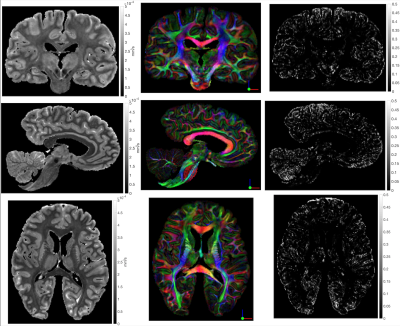 |
 Development of a diffusion-weighted SSFP acquisition and processing pipeline to quantify the diffusion properties of the post-mortem ALS brain at 7T Development of a diffusion-weighted SSFP acquisition and processing pipeline to quantify the diffusion properties of the post-mortem ALS brain at 7T
Benjamin Tendler, Saad Jbabdi, Sean Foxley, Menuka Pallebage-Gamarallage, Moises Hernandez Fernandez, Ricarda Menke, Thomas Nichols, Martin Turner, Olaf Ansorge, Karla Miller
An acquisition and processing pipeline is outlined to quantify the diffusion properties of post-mortem brain samples from diffusion-weighted steady-state free precession (dwSSFP), as part of an ongoing project examining the impact of amyotrophic lateral sclerosis (ALS) on the human brain. Preliminary results are presented comparing the post-mortem diffusion properties of control brains and patients diagnosed with ALS over the corpus callosum. Clear trends are observed within the results, with a maximum deviation between control and ALS brains observed within callosal regions connecting the motor cortices in the two hemispheres.
|
08:12
|
1028.
 |
 Optimization of advanced high-resolution diffusion-weighted imaging (DWI) techniques in lower neck imaging Optimization of advanced high-resolution diffusion-weighted imaging (DWI) techniques in lower neck imaging
Tong Su, Yu Chen, Tianyi Qian, Wei Liu, Huadan Xue, Zhengyu Jin, Zhuhua Zhang, Hailong Zhou
Readout-segmented echo-planar imaging (rs-EPI) could significantly reduce magnetic susceptibility artifacts in head and neck regions. In this study, the images were qualitatively evaluated among three types of rs-EPI: with and without readout partial Fourier (RPF), and with simultaneous multi-slice (SMS) technique. The SNRs and CNRs were compared with the additional use of special surface coils (SC). There was no significant differences in the image quality, SNRs, or CNRs among three rs-EPI acquisition methods of all the 31 volunteers and 9 hypopharyngeal carcinoma patients. Markedly, the special surface coils offered better image quality for the evaluation of lower neck lesions.
|
08:24
 |
1029.
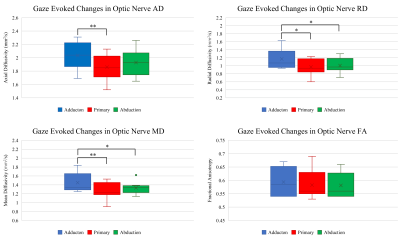 |
 Gaze Evoked Changes in Diffusion Characteristics of Human Optic Nerve Gaze Evoked Changes in Diffusion Characteristics of Human Optic Nerve
Kenneth Wengler, Tao Wang, Patricia Stefancin, Patrick Sibony, Tim Duong, Xiang He
Disorders of the optic nerve (ON) are both life and sight threatening. Although disorders such as papilledema and ischemic optic neuropathy cause deformation of the peripapillary basement membrane layer, earlier pathological changes to the ON may occur further away from the eye. In this study a novel zoom-RESOLVE DTI method was developed for in vivo human ON imaging. Significant changes were observed in diffusion characteristics when comparing adduction, primary position and abduction. Gaze evoked changes in diffusion characteristics have the potential to assess diseases that affect the optic nerve before manifestation of ocular anatomical changes observed in OCT.
|
08:36
|
1030.
 |
 The connectivity fingerprint of the fusiform gyrus predicts the Autism Observation Scale for Infants (AOSI) in Tuberous Sclerosis Complex The connectivity fingerprint of the fusiform gyrus predicts the Autism Observation Scale for Infants (AOSI) in Tuberous Sclerosis Complex
Benoit Scherrer, Kush Kapur, Anna Prohl, Jurriaan Peters, Xavier Tomas-Fernandez, Darcy Krueger, Mustafa Sahin, Simon Warfield
Autism spectrum disorder is characterized by severe deficits in face processing. We achieved MR diffusion imaging of 27 infants (~2yo) with Tuberous Sclerosis Complex, a population at risk of autism, and assessed whether the structural connectivity fingerprint of their fusiform gyrus, a central region in face perception, can predict the Autism Observation Scale for Infants total score. We found that the diffusion tensor imaging connectivity fingerprint had poor prediction capabilities. In contrast, a diffusion compartment imaging, fixel-based fingerprint captured the structure of the abnormal connectivity in infants at risk of ASD and allowed in-sample prediction with a correlation of 0.97.
|
08:48
|
1031.
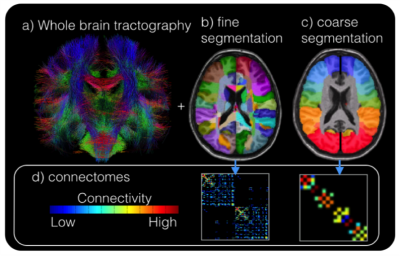 |
 U-fiber, Long-range, and Inter-limbic Tractography Comparison in Epilepsy Patients at 7 Tesla U-fiber, Long-range, and Inter-limbic Tractography Comparison in Epilepsy Patients at 7 Tesla
John Rutland, Rebecca Feldman, Lara Marcuse, Madeline Fields, Bradley Delman, Rafael O'Halloran, Priti Balchandani
This study measures alterations in wholebrain connectivity and connectivity of the suspected seizure onset zone (SOZ) in MRI-negative epilepsy patients. Short-range (U-fibers), long-range, and inter-limbic white matter tracts were measured independently in a group of 19 epilepsy subjects and 10 healthy controls using diffusion imaging. Relative wholebrain hypo-connectivity of both U-fibers and inter-limbic fibers was found in epilepsy subjects. Additionally, hyper-connectivity of all 3 fiber types was found in SOZ regions compared with non-SOZ regions. These findings suggest abnormal connectivity in MRI-negative patients may prove useful in SOZ localization and treatment planning.
|
09:00
|
1032.
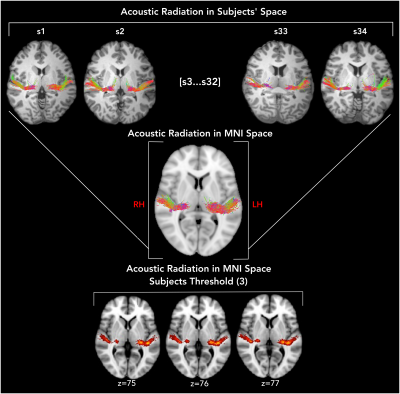 |
 Diffusion-based tractography atlas of the human acoustic radiation Diffusion-based tractography atlas of the human acoustic radiation
Chiara Maffei, Silvio Sarubbo, Jorge Jovicich
This study presents the first tractography-based atlas of the acoustic radiation from a population of 34 young healthy subjects. The atlas was constructed using high quality MRI data from the Human Connectome Project. The acoustic radiation reconstruction was optimized with a systematic evaluation of MRI acquisition and analysis parameters using as reference reconstructions validated from an ex-vivo dissection study from our group (Maffei et al., 2017). The optimized reconstruction parameters and the atlas may be used in future studies interested in identifying and characterizing the acoustic radiation.
|
09:12
|
1033.
 |
 OGSE- versus PGSE-derived ADC measurements in patients with liver metastases show reduced hindrance to diffusion at short length scales OGSE- versus PGSE-derived ADC measurements in patients with liver metastases show reduced hindrance to diffusion at short length scales
Mihaela Rata, David Collins, Maria Bali, Thorsten Feiweier, Julie Hughes, Erica Scurr, Matthew Orton, James d`Arcy, Martin Leach, Dow-Mu Koh
The oscillating gradient spin echo (OGSE) diffusion method probes the diffusion spectrum at defined length scales. This comparative study investigates the effect of short diffusion times on apparent diffusion coefficient (ADC) measurements using OGSE and PGSE diffusion sequences in six patients with liver metastases. Similar cohort mean ADC values were reported for all PGSE measurements, while the OGSE-derived ADC was significantly higher (paired t-test p-value=0.029). This increase in OGSE-measured ADC in liver tumours suggests that water molecules suffer less hindrance at shorter diffusion times (as already observed in brain studies) and provides additional information regarding the tissue microstructure.
|
09:24
|
1034.
 |
 Prostate microstructure specificity with diffusion relaxometry Prostate microstructure specificity with diffusion relaxometry
Gregory Lemberskiy, Els Fieremans, Jelle Veraart, Andrew Rosenkrantz, Dmitry Novikov
We identify the contributions of prostate cellular and glandular compartments to the overall diffusion time-dependent diffusion tensor, by varying echo time and relying on their different T2 values. We test the functional form of compartment tensor eigenvalues with respect to the diffusion time against a variety of tissue models, and find the glandular tissue being best described by the short-time surface-to-volume limit, whereas the random permeable barrier model is most applicable in cellular tissue, and for tumors of various grade. Our framework allows quantification of glandular sizes, cellular fiber diameters, membrane permeability, compartment T2-values, and volume fractions.
|
09:36
|
1035.
 |
 High resolution diffusion MRI maps of mice with normal and dysfunctional placentas reveal clear fetal differences High resolution diffusion MRI maps of mice with normal and dysfunctional placentas reveal clear fetal differences
Qingjia Bao, Eddy Solomon, Ron Hadas, Stefan Markovic, Michal Neeman, Lucio Fydman
DWI could evaluate pregnancy-related dysfunctions, yet EPI’s sensitivity to motions and air/water/fat heterogeneities prevent these studies in preclinical settings. We developed DWI methodologies based on SPatiotemporal ENcoding (SPEN) for overcoming these obstacles, delivering ADC images at ≈150Ám resolutions. We demonstrate the power of these new methods to resolve placental layers (maternal, fetal, trophoblastic) and umbilical cords, as well as brain features in developing mice fetuses. Daily monitoring of pregnancies for na´ve and for eNOS-/- mice also showed differences in the development of placental and fetal (e.g. brain) structures. SPEN DWI thus opens the potential for the early detection of pregnancy disorders.
|
09:48
|
1036.
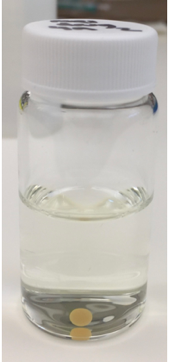 |
 A Pilot Study of Correlations Between Mean Diffusivity and Drug Release Over Time For an Implantable Drug Delivery System A Pilot Study of Correlations Between Mean Diffusivity and Drug Release Over Time For an Implantable Drug Delivery System
Nicole Vike, Xin Li, Kelsey Hopkins, Joseph Rispoli, Luis Solorio
In situ forming implants (ISFI) allow for precise placement of a drug eluting depot into the body, using a simple injection. However, the properties of the injection sites can alter the drug release profile in situ. Diffusion weighted imaging (DWI) provides a method for non-invasively and nondestructively tracking changes in the implant diffusivity in situ. Using DWI, we have characterized the diffusivity profile of ISFIs made using a poly(lactic-co-glycolic) acid polymer, loaded with the mock drug fluorescein. The ability to characterize the diffusivity profile of implants in situ, will provide the necessary tools for improving the rational design of implants.
|
|












